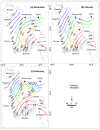Developing a Cold-Related Mortality Database in Bangladesh
- PMID: 36231477
- PMCID: PMC9566719
- DOI: 10.3390/ijerph191912175
Developing a Cold-Related Mortality Database in Bangladesh
Abstract
The aim of this study was to develop a database of historical cold-related mortality in Bangladesh using information obtained from online national newspapers and to analyze such data to understand the spatiotemporal distribution, demographic dynamics, and causes of deaths related to cold temperatures in winter. We prepared a comprehensive database containing information relating to the winter months (December to February) of 2009-2021 for the eight administrative divisions of Bangladesh and systematically removed redundant records. We found that 1249 people died in Bangladesh during this period due to cold and cold-related illnesses, with an average of 104.1 deaths per year. The maximum number of cold-related deaths (36.51%) occurred in the Rangpur Division. The numbers were much higher here than in the other divisions because Rangpur has the lowest average monthly air temperature during the winter months and the poorest socioeconomic conditions. The primary peak of cold-related mortality occurred during 21-31 December, when cold fronts from the Himalayas entered Bangladesh through the Rangpur Division in the north. A secondary peak occurred on 11-20 January each year. Our results also showed that most of the cold-related mortality cases occurred when the daily maximum temperature was lower than 21 °C. Demographically, the highest number of deaths was observed in children aged six years and under (50.68%), followed by senior citizens 65 years and above (20.42%). Fewer females died than males, but campfire burns were the primary cause of female deaths. Most mortality in Bangladesh was due to the cold (75.5%), cold-triggered illness (10.65%), and campfire burns (5.8%). The results of this research will assist policymakers in understanding the importance of taking necessary actions that protect vulnerable public health from cold-related hazards in Bangladesh.
Keywords: campfire; climate (temperature); cold wave; demography; disaster; poverty; public health; socioeconomic.
Conflict of interest statement
The authors declare no conflict of interest.
Figures







References
-
- Lu L., Wang Z., Shi P. Mapping Cold Wave Risk of the World. In: Shi P., Kasperson R., editors. World Atlas of Natural Disaster Risk. Springer; Berlin/Heidelberg, Germany: 2015. pp. 189–207.
-
- Federal Emergency Management Agency (US) Cold Wave. [(accessed on 20 September 2022)]; Available online: https://hazards.fema.gov/nri/cold-wave#:~:text=A%20Cold%20Wave%20is%20a,....
-
- Karmakar S. Patterns of Climate Change and Its Impacts in Northwestern Bangladesh. J. Eng. Sci. 2019;10:33–48.
-
- Roy U., Singh A., Rahman M.W., Chowdhury M.T. To Date Situation of Highly Pathogenic Avian Influenza (HPAI) H5N1 in Bangladesh: A Review; Proceedings of the 3rd International Conference on Environmental Aspects of Bangladesh [ICEAB 2012]; Fukuoka, Japan. 13–14 October 2012; pp. 84–86.
-
- Akhter A., Rahim A. Bangladesh Cold Wave Leaves at Least 50 Dead. [(accessed on 12 January 2022)]. Available online: https://www.japantimes.co.jp/news/2019/12/29/world/bangladesh-cold-wave-...
MeSH terms
LinkOut - more resources
Full Text Sources

